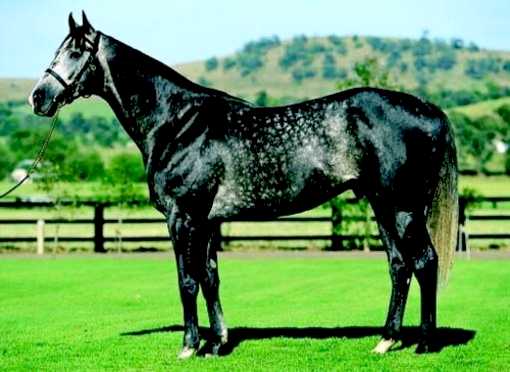
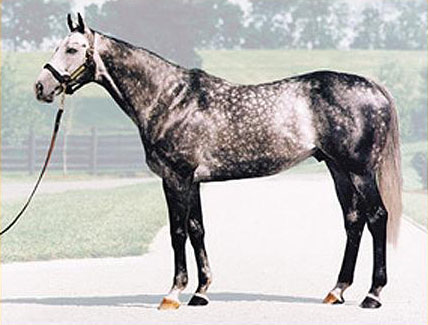
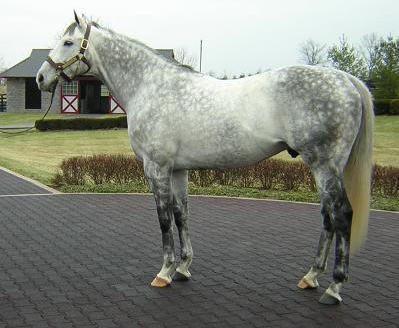
The Grey Modifier
(or, why 99.9% of "roan" TBs are actually grey)
| Many grey Thoroughbreds are registered as grey/roan or even just as roan due to confusion that still exists regarding the differences between these two distinct colors. Grey is a gene that modifies the horse's existing coat color (bay, chestnut, etc) by slowly de-pigmenting all of the hairs of the coat as the horse ages. It's a process akin to the greying of human hair. All grey horses are born the color of their base coat, but most will have a few grey hairs around the eyes and muzzle, indicating the presence of the grey gene. As the horse ages, the grey hairs will spread from the face all through the coat. Many grey horses dapple as they age, and eventually end up a very light grey or "white" shade. Below are pictures showing the progression of the greying process on Unbridled's Song. (Photos by ?) |
 |
 |
 |
| Some greys retain odd patches of color known as "bloody shoulder marks" though the marks can occur on the neck, barrel, and elsewhere as well. These are somatic mutations, essentially places on the coat where the grey gene misfired. The mare Charmander, shown below while racing and a few years later, is a nice example of this. (Photos by ?) |
 |
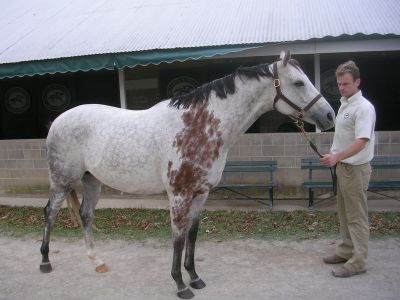 |
| Unlike greys, roan horses remain the same color throughout their lives. Roan acts similarly to agouti and cream in that it only affects the body hairs and not the hairs of the legs, mane, and tail. Thus, roan horses will always have dark heads, legs, manes, and tails, and their bodies will have white hairs mixed in with the coat color no matter what age they are. Until 1992, the roan gene did not exist in the Thoroughbred gene pool (see the Catch A Bird section below for details). Any Thoroughbreds not descended from Catch A Bird that are registered as roan are actually grey and will lighten with age. (The confusion seems to have arisen from bay and chestnut horses that turned grey because they often go through a stage where their coat color is very muddy and looks somewhat similar to roan.) |
|
|
|
| *The Catch A Bird Exception: The only exception to the
statement that there are no true, dark-headed roan TBs has cropped up
very recently. In 1982, a very unusually marked Thoroughbred was born
in New Zealand named Catch A Bird. He looks like a bay horse with white
brindling, the opposite of the dark lines seen on "normal" brindles.
Stranger still, as a stallion, Catch A Bird produced four offspring that
appeared to be (phenotypically) true, dark-headed roans, indicating that
Catch A Bird probably carries a one-time KIT-mutation that has produced
roan. His four roan offspring are: Odd Colours (1992 mare), Slip Catch
(1993 mare), Goldhill Park (1994 horse), and Red Noble (1996 gelding).
Only Slip Catch has been bred, and she has produced two roan foals, Lavender
Fields and Lilac Hill. Slip Catch and her foals were rescued from
terrible neglect by Winning
Colors Farm in Australia where their rare color is being preserved
and promoted. Please note that these six horses appear to be the only true roan TBs in existence. All other horses registered as roan or grey/roan worldwide are actually greys. For pictures, please see my page on Roan Thoroughbreds: A New Mutation. |
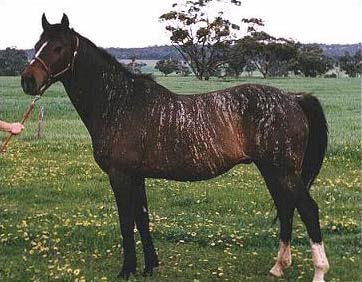 |
Catch A Bird, the well-spring of what is believed to be a new mutation in Thoroughbreds. |
Rabicano: More Confusion with Roan
| Pictured below (left) is Colorful Tour winning the 2003 Essex Stakes. He is a chestnut rabicano, a pattern that is often confused with true dark-headed roan. The specific mechanism behind rabicano is unknown, but given that roan, sabino, and white spotting (formerly dominant white)---all three are patterns of white that can manifest as white ticking---are all located on KIT, it seems likely that rabicano is related in some fashion. There is some thought that it may be an expression of sabino. It is usually manifested as a sprinkling of white hairs radiating out from the horses flank. Some horses have ticking all the way across their barrel and flanks. Rabicanos also usually have a white-topped tail, known as a coon tail or skunk tail. |
|
|
|